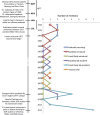The Reemergent 1977 H1N1 Strain and the Gain-of-Function Debate
- PMID: 26286690
- PMCID: PMC4542197
- DOI: 10.1128/mBio.01013-15
The Reemergent 1977 H1N1 Strain and the Gain-of-Function Debate
Abstract
The 1977-1978 influenza epidemic was probably not a natural event, as the genetic sequence of the virus was nearly identical to the sequences of decades-old strains. While there are several hypotheses that could explain its origin, the possibility that the 1977 epidemic resulted from a laboratory accident has recently gained popularity in discussions about the biosafety risks of gain-of-function (GOF) influenza virus research, as an argument for why this research should not be performed. There is now a moratorium in the United States on funding GOF research while the benefits and risks, including the potential for accident, are analyzed. Given the importance of this historical epidemic to ongoing policy debates, we revisit the evidence that the 1977 epidemic was not natural and examine three potential origins: a laboratory accident, a live-vaccine trial escape, or deliberate release as a biological weapon. Based on available evidence, the 1977 strain was indeed too closely matched to decades-old strains to likely be a natural occurrence. While the origin of the outbreak cannot be conclusively determined without additional evidence, there are very plausible alternatives to the laboratory accident hypothesis, diminishing the relevance of the 1977 experience to the modern GOF debate.
Copyright © 2015 Rozo and Gronvall.
Figures


Comment in
-
The 1977 H1N1 Influenza Virus Reemergence Demonstrated Gain-of-Function Hazards.mBio. 2015 Sep 29;6(5):e01434-15. doi: 10.1128/mBio.01434-15. mBio. 2015. PMID: 26419881 Free PMC article. No abstract available.
-
Reply to "The 1977 H1N1 Influenza Virus Reemergence Demonstrated Gain-of-Function Hazards".mBio. 2015 Sep 29;6(5):e01524-15. doi: 10.1128/mBio.01524-15. mBio. 2015. PMID: 26419883 Free PMC article. No abstract available.
References
-
- Zakstelskaja LJ, Yakhno MA, Isacenko VA, Molibog EV, Hlustov SA, Antonova IV, Klitsunova NV, Vorkunova GK, Burkrinskaja AG, Bykovsky AF, Hohlova GG, Ivanova VT, Zdanov VM. 1978. Influenza in the USSR in 1977: recurrence of influenzavirus A subtype H1N1. Bull World Health Organ 56:919–922. - PMC - PubMed
-
- Office of Science and Technology Policy 17 October 2014. Doing diligence to assess the risks and benefits of life sciences gain-of-function research. Office of Science and Technology Policy, White House, US government. http://www.whitehouse.gov/blog/2014/10/17/doing-diligence-assess-risks-a... Accessed 3 June 2015.
MeSH terms
Substances
LinkOut - more resources
Full Text Sources
Medical

